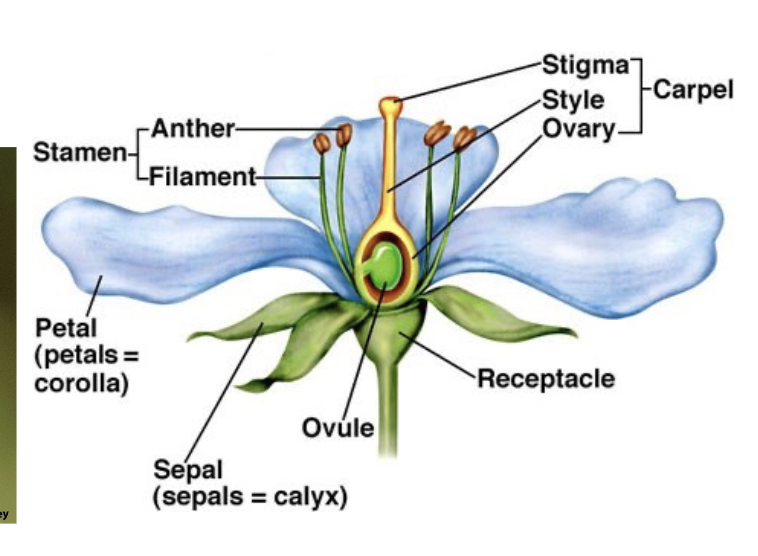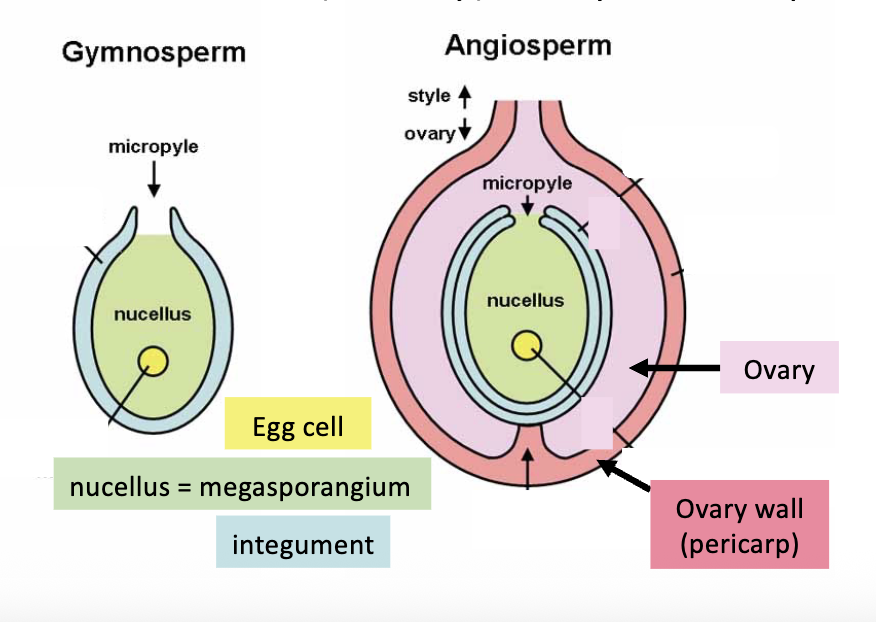Plants 5 - Angiosperms
1/20
There's no tags or description
Looks like no tags are added yet.
Name | Mastery | Learn | Test | Matching | Spaced |
|---|
No study sessions yet.
21 Terms
new advangtages of pollen and seeds
more varied dispersal (pollen) & better and cooler dispersal (seeds)
adaptive raditation
when one lineage produces large number of descendent species adapted to many habitats/ecological niches *angiosperm are prime example
Cretaceous Terrestrial Revolution
145-80 mya
angiosperm go from ~0 → 75% of worlds flora
life becomes more diverse on land than the oceans?
3 Adaptations That were key to Angiosperm Revolution
more efficient xylem - vessel element with complete perferation and increases conducting system efficiency
flowers
fruit
these adaptation allow transport of seeds and pollen efficiently
**but note that gymnosperms had many of these traits too (or similar/developing)
adaptation trait most associated with speciation
flowers - allow for reproductive isolating bc they are directly involved in mate choice and mating…can reduce probability that lineages can mate
Flower Structure
Female Parts (Carpel) made of stigma, style, and ovary containing ovule
Male Parts (Stamen) made of anther containing pollen grains, filament

4 structures of flower that becomes extremely diversified
carpel, stamen, sepals (leafy structures at bottom of flower), and petals
Pollination Definition
the transfer of pollen from the male part (anther) of a flower to the female part (stigma)
Outcross Pollination
*the goal - involves the pollen and stigma on different plants
adaptive signifigance of floral traits
can attract good pollinators and deter bad ones or non pollinators
can manipulate visitor behaviour to maximize pollen transfer (bending, shape, size)
what traits can affect pollination
all of them! colour, scent, shape, UV markings, positition of flower
pollination and speciation
pollination is def involved in speciation by causing reproductive isolation in 2 ways
pollinator shifts - due to simple changes…colour, nectar spur length, flowering length
mutation of floral trait…proven with white/pink flowers and moth/bee pollination
begining of adaptive radiation
no thing kickstarted (neither flower/pollination)
gymnosperms had pollinators to
decline in diversity and plant/pollinator relations
boring flowers for a while
Fruit structure and function
*key innovation
ovules develop into having an additional ovary tissue
this tissue adapts into many things (milkweed fluff, burrs)
these protect developing seed and help with seed dispersal
*sometimes meant to be eaten and pooped out
Cotelydons
structures of plants when they first sprout and don’t have leaves…store nutrience for embryos
Monocot vs Dicot Features
Monocot:
1 cotelydon
parallel viens
multiples of 3 petals
Dicots
2 cotelydon
branched viens
multiples of 4/5 petals
*actually easier to distiguish viens rather than cotelydon #s
Humans and Angiosperms
allowed for radiation of human cuisine
huge markets of flowers historically and now
monocoat lineages
grasses, bananas, irises, trilliums, orchids, lillies
*monocots evolved from dicots kind of
pollinator shift
when a plant species adapts to be pollinated by a different type of pollinator, leading to changes in floral traits and can eventually drive the evolution of new species
difference between gymnosperms and angiosperms
angiosperms enclose ovule in ovary…fruit develops from ovary tissue (ripening)
angios only group to have fruit and flowers

signifigance of plant modularity
so many copies of redudant limbs and organs and room for failure compared to humans…with one mutation of a limb…humans at a large disadvantage…mutation more likely to be harmful
with plants mutations are more likely to be neutral/benficial because of this modularity…generally more flexible than animal body plans